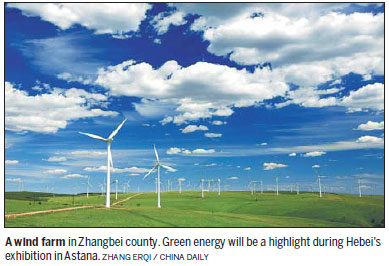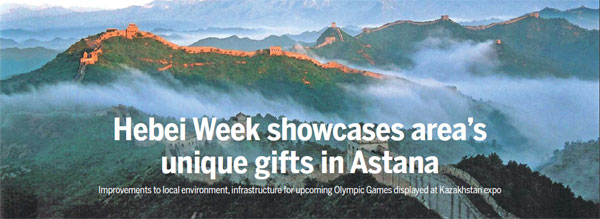Hebei Week showcases area's unique gifts in Astana
Improvements to local environment, infrastructure for upcoming Olympic Games displayed at Kazakhstan expo
During the ongoing Astana Expo 2017 being held in the capital of Kazakhstan from June to September, Hebei province in North China is displaying its business opportunities through the Hebei Week activity.
During the Hebei Week being held from July 12 to 16, the province is offering a series of events including a business-matching fair for the new energy sector, a forum on industrial capacity cooperation between Hebei and countries involved in the Belt and Road Initiative, a Hebei-Central Asia exported commodities fair, a promotional meeting for the 2022 Winter Olympic Games and a rich variety of shows.

According to officials from the Hebei delegation to Astana, the province is now embracing unprecedented opportunities for its development.
One such opportunity is the national strategy for the integration of the Beijing-Tianjin-Hebei regions.
The regional integration plan was proposed by the Chinese government in 2014, aiming to achieve common prosperity through sharing resources, coordinating industrial developments and facilitating interconnectivity.
An important scheme of the integration plan is the Xiongan New Area, which was proposed by central authorities earlier this year.
The New Area, about 100 kilometers southwest of downtown Beijing, will span the three counties of Xiongxian, Rongcheng and Anxin that sit at the center of the triangular area formed by Beijing, Tianjin and Hebei's provincial capital, Shijiazhuang.
The move will help redistribute functions from Beijing that are not related to the capital, explore a new model of optimized development in densely-populated areas and restructure the urban layout in the Beijing-Tianjin-Hebei region.
The New Area will cover around 100 square kilometers initially, before expanding to 200 sq km and then to about 2,000 sq km in the final phase.
Xiongan's priority will be serving as a new home for Beijing's "non-capital" functions, bringing in some of Beijing's administrative organs, large enterprises, financial institutions, colleges and research institutions.
Authorities intend to transform the region into a new growth pole as China's economy slows, according to reports from Xinhua News Agency.
In addition to receiving the noncapital functions of Beijing, the regional integration scheme will bring close industrial cooperation, shared use of transport, telecommunication and public service resources, and coordinated efforts in environmental protection in Hebei.
The Beijing-Tianjin-Hebei region is a large market with 120 million people. It is one of the most economically dynamic regions in China.
Hebei holds an important position in the region as a traffic hub in China.
Hebei has seven airports. The New Capital International Airport - the largest airport in Asia - is under construction in the area between Beijing and Hebei's Langfang city. The integration plan will give further transport facilitation for Hebei to use the airports in Beijing and Tianjin.
Hebei has more than 6,500 km of expressways and more than 7,166 km of railways. It has three large seaports in Qinhuangdao, Tangshan and Huanghua, serving as an important gateway for foreign trade between North China and the world.
Hebei is a major industrial province in North China, with gross regional product surpassing 3 trillion yuan ($441 billion) in 2016.
While consolidating and upgrading its traditional industries such as steel, cement, glass and machinery, Hebei has shown growing competitiveness in new and emerging sectors including information technology, biomedicine, new and clean energies, new materials and robots.
The province is willing to share its industrial strength with countries related to the Belt and Road Initiative and to transfer its advanced industrial capacities.
The new energy sector is a highlight of the Hebei Week in Astana. The province is exhibiting a number of projects in the field for industrial capacity cooperation.
zhaoshijun@chinadaily.com.cn
|
Hebei has one of the best-preserved sections of the Great Wall, providing educational entertainment for tourists from the Shanhai Pass to ZhangjiaKou.Provided To China Daily |

(China Daily 07/14/2017 page17)















